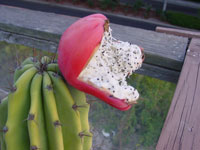
Cereus peruvianus |
1. Cereus peruvianus While not a verified species, this plant is very popular in cultivation and is often passed
along as a large landscape cutting. Many monstrose forms of this plant exist as well. To see more pictures of
"Cereus peruvianus" click here.
And don't miss the article about this common, yet uncertain plant.
|
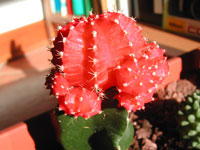
Gymnocalycium cultivars |
2. Grafted Gymnocalycium Cultivars This is actually two cacti in one! The top part is a Gymnocalycium that
lacks chlorophyll and that gives it the bright red color. However, because the plant has no chlorophyll, it cannot
survive on its own. This is why they are grafted on a green stalk below. The green stalk is typically a Hylocereus species. For
more information on "Grafted Gymnocalycium Cultivars" click here.
I also highly recommend this website for
everything you want to know about these plants and more. Photo by: Sara Burbi
|
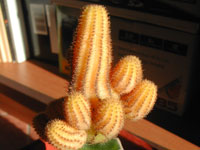
Echinopsis chamaecereus cultivar |
3. Echinopsis chamaecereus cultivar Just like the Gymnocalycium above, this Echinopsis cultivar is another plant that
lacks chlorophyll, which makes it yellow and unable to survive on its own. The green stalk below is also typically a Hylocereus species. For
more information on "Echinopsis chamaecereus Cultivars" click here.
This website also covers these plants in
great detail.
More detailed info click here.
Photo by: Sara Burbi
|
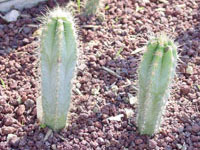
Pilosocereus pachycladus |
4. Pilosocereus pachycladus If you have a columnar cactus that is blue in color, there is about a 90% chance that
it is going to be P. pachycladus. The unusual blue color of this plant and the fact that it is easy to grow make it a perfect
candidate for big commercial growers. There are other blue columnar cacti out there, but your plant came from a nursery that
does not specialize in cacti, this is almost certainly what you have. To see more pictures of
"Pilosocereus pachycladus" click here.
|
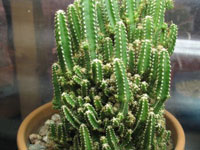
Cereus tetragonus |
5. Cereus tetragonus -"Fairy Castles" Much like C. peruvianus, C. tetragonus is widespread, but
the true identity of this plant is unknown. It may even be a mutation of C. peruvianus. It does not occur in the
wild and I have yet to encounter anyone who has had flowers on their plant. It seem then that this plant was
selected for its tight, upright growth, small size, and ease of care. This might be one instance where the
common name is more appropriate than the scientific name. To see more pictures of
"Cereus tetragonus -"Fairy Castles"" click here.
Note: This cactus is often sold with straw flowers glued on them.
Photo by: Tony Marino
|

A. subulata monstrose |
6. Austrocylindropuntia subulata monstrose The monstrose form of A. subulata is a curious little
thing that looks like a bunch of chubby thumbs all stuck together with warts on it. I suppose it is just
this odd appearance that makes it popular at stores. People are likely to buy it for "shock value." At the same time
the little stem pieces break off fairly easily and each piece will quickly grow to its own plant.
Photo by: Tony Marino
|

Opuntia microdasys |
7. Opuntia microdasys This Opuntia species comes in three forms. They are easy to tell apart by the
color of thier glochids. (Glochids are the tiny little spines that cover the plant.) The most popular form of O. microdasys
is the form with white glochids. There is a form with yellow glochids that often has monstrose growth. And finally there
is a form with cinnamon-colored glochids. All three are often sold as "Bunny ears" and increase in size in the same order
that they are listed here. While the white form has glochids that often are too soft to penetrate the skin, the
cinnimon form is quite viscious and can be very unpleasent to bump into. The yellow falls somewhere in-between.
To see more pictures of "Opuntia microdasys" click here.
More detailed info click here.
|
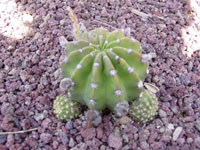
Echinopsis species |
8. Echinopsis species Many Echinopsis species are grown because they are quite
hardy and easy to care for and they produce some of the most showy blooms of all cacti. It is not uncommon for an Echinopsis
stem to be completely hidden by a mass of large flowers at the end of long floral tubes. Many hybrids of this genera
are sold, but some true species are just as popular, if not more popular than hybrids. The two most popular Echinopsis species are
E. subdenudata and
E. oxygona. To see some of the other species and
hybrids click here.
|
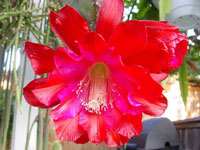
Epiphyllum hybrids |
9. Epiphyllum hybrids A popular houseplant that often gets handed down from generation to generation,
I often get ID requests for "a cactus that my grandmother gave me". Often, these plants are grown in low lighting
conditions and therefore do not bloom for many years. Then for whatever reason, the plant will put out a few flowers
and totally amaze the owner! While these flowers can come in a variety of colors, all of them are quite showy. There are
few true species out there, but the majority of these plants are hybrids.
To learn more about Epiphyllum hybrids, visit this website.
|

Stenocereus pruinosus |
10. Stenocereus pruinosus I'm not sure exactly what makes this species so popular. Perhaps it is
easy to grow from seed. But this species shows up for ID quite frequently because most plants are sold as juveniles.
And with columnar cacti, most young plants look very different than the adult plants. Because of this, you could have
an adult plant and a young plant sitting side by side and not even realize they are the same species.
To see a pictures of a full grown "Stenocereus pruinosus" click here.
|